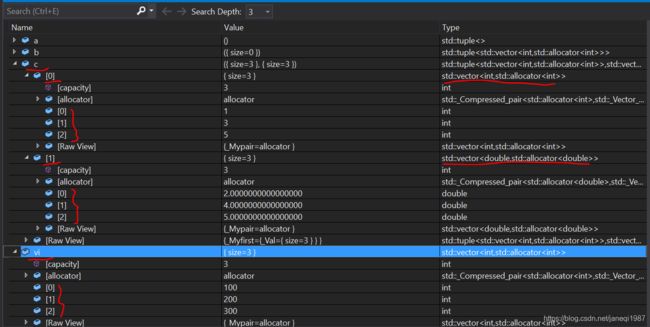c++11函数模板的默认模板参数 和 可变参数模板函数
转自:https://www.cnblogs.com/lsgxeva/p/7787500.html
#define _CRT_SECURE_NO_WARNINGS
#include
#include
#include
#include
// C++11之前,类模板是支持默认的模板参数,却不支持函数模板的默认模板参数
//1、普通函数带默认参数,c++98 编译通过,c++11 编译通过
void DefParm(int m = 3) {}
//2、类模板是支持默认的模板参数,c++98 编译通过,c++11 编译通过
template
class DefClass {};
//3、函数模板的默认模板参数, c++98 - 编译失败,c++11 - 编译通过
template
void DefTempParm() {}
// 类模板的默认模板参数必须从右往左定义,函数模板的默认模板参数则没这个限定
template
template
template
template
template
template
void mytest()
{
return;
}
int main()
{
mytest();
system("pause");
return 0;
}
===============================================================
#define _CRT_SECURE_NO_WARNINGS
#include
#include
#include
#include
// 在C++11之前,类模板和函数模板只能含有固定数量的模板参数。C++11增强了模板功能,允许模板定义中包含0到任意个模板参数,这就是可变参数模板。
// 可变参数模板和普通模板的语义是一样的,只是写法上稍有区别,声明可变参数模板时需要在typename或class后面带上省略号“...”
/*
省略号“...”的作用有两个:
1) 声明一个参数包,这个参数包中可以包含0到任意个模板参数
2) 在模板定义的右边,可以将参数包展开成一个一个独立的参数
*/
template
void func(T ... args) // T叫模板参数包,args叫函数参数包
{//可变参数模板函数
}
func(); // OK:args不含有任何实参
func(1); // OK:args含有一个实参:int
func(2, 1.0); // OK:args含有两个实参int和double
// 一个可变参数模板函数的定义
template
{//可变参数模板函数
//sizeof...(sizeof后面有3个小点)计算变参个数
cout << "num = " << sizeof...(args) << endl;
}
// 通过递归函数展开参数包,需要提供一个参数包展开的函数和一个递归终止函数。
//递归终止函数
void debug()
{
cout << "empty\n";
}
//展开函数
template
void debug(T first, Args ... last)
{
cout << "parameter " << first << endl;
debug(last...);
}
// 非递归方式展开
template
void print(T arg)
{
cout << arg << endl;
}
template
void expand(Args ... args)
{
int a[] = { (print(args), 0)... };
}
void mytest()
{
func1(); // num = 0
func1(1); // num = 1
func1(2, 1.0); // num = 2
debug(1, 2, 3, 4);
/*
运行结果:
parameter 1
parameter 2
parameter 3
parameter 4
empty
*/
expand(1, 2, 3, 4);
return;
}
int main()
{
mytest();
system("pause");
return 0;
}
========================================================================================
#define _CRT_SECURE_NO_WARNINGS
#include
#include
#include
#include
// 在C++11之前,类模板和函数模板只能含有固定数量的模板参数。C++11增强了模板功能,允许模板定义中包含0到任意个模板参数,这就是可变参数模板。
// 可变参数模板类 继承方式展开参数包
// 可变参数模板类的展开一般需要定义2 ~ 3个类,包含类声明和特化的模板类
template
template
class BMW
{//当实例化对象时,则会引起基类的递归构造
public:
BMW()
{
printf("type: %s\n", typeid(Head).name());
}
Head head;
};
template<> class BMW<>{}; // 边界条件
// 模板递归和特化方式展开参数包
template
template
struct Multiply
{
static const long val = first * Multiply
};
template<>
struct Multiply<> // 边界条件
{
static const long val = 1;
};
void mytest()
{
BMW
/*
运行结果:
type: f
type: c
type: i
*/
std::cout << Multiply<2, 3, 4, 5>::val << std::endl; // 120
return;
}
int main()
{
mytest();
system("pause");
return 0;
}
/
变长模板参数的其他应用:
#include
#include
#include
template
using VT = std::vector;
template
using store = std::tuple...>;
int main()
{
store<> a;
store b;
store c{ {1,3,5}, {2.0, 4.0, 5.0} };
VT vi{ 100,200,300 };
for (const auto& item : vi)
{
std::cout << item << std::endl;
}
std::cout << std::endl;
return 0;
} 结果如下:
